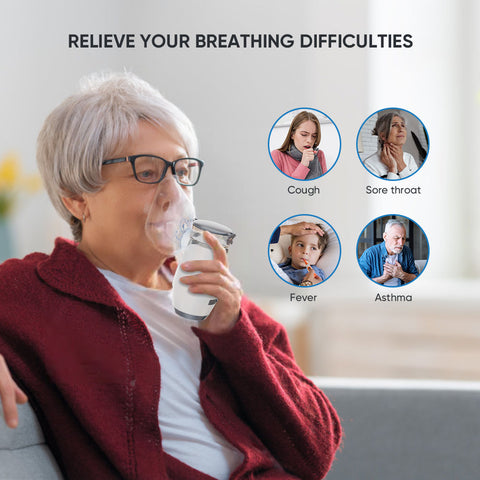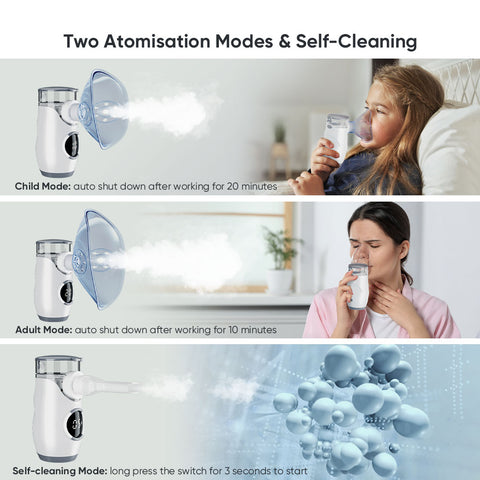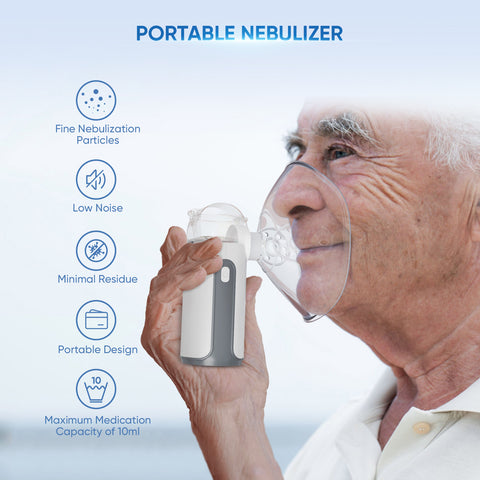
Nebulizers vs. Home Oxygen Concentrators: Understanding the Difference for Effective Nebulizer Therapy
Many people with respiratory conditions rely on medical devices to manage their breathing difficulties. Two commonly used tools are nebulizer therapy and home oxygen concentrators (HOCs). However, it's crucial to understand the key distinctions between these devices, as they serve different purposes in respiratory health.
This blog post from VARON, a trusted provider of respiratory equipment, dives deep into the world of nebulizers and home oxygen concentrators. We'll explore their functionalities, applications, and how they can benefit your respiratory health journey.
Nebulizer Therapy: Delivering Medication Directly to Your Lungs
A nebulizer is a compact medical device that transforms liquid medication into a fine mist for inhalation. This mist can be easily inhaled deep into the lungs, delivering medication directly to the airways. Nebulizer therapy is particularly beneficial for treating respiratory conditions like asthma, chronic obstructive pulmonary disease (COPD), and cystic fibrosis.
How Nebulizer Therapy Work
VARON offers a range of user-friendly nebulizers, including the MY-135B, MY-133, and MY-132 models. These nebulizers all utilize mesh nebulization technology. Here's a breakdown of the process:
- Medication Chamber: You fill the nebulizer's medication chamber with the prescribed liquid medication.
- Mesh Vibrates: When activated, the nebulizer's mesh vibrates at a high frequency.
- Fine Mist Formation: This vibration breaks down the medication into a fine mist of particles typically less than 5 micrometers (μm) in size. These tiny particles are easily inhaled deep into the lungs.
- Inhalation: The patient inhales the medication mist through a mouthpiece or mask, depending on their preference and comfort level.
Benefits of Nebulizer Therapy
- Targeted Treatment: Nebulizer therapy delivers medication directly to the airways, maximizing its effectiveness in treating respiratory conditions.
- Fast-Acting Relief: Inhaled medication often provides quicker relief from symptoms compared to oral medications.
- Suitable for All Ages: Nebulizer therapy can be used by people of all ages, including children and adults. VARON's nebulizers, like the MY-133, even come with child-sized masks for optimal comfort.
- Portable: Nebulizers are compact and lightweight, making them ideal for use at home or on the go. VARON's nebulizers feature an eco-friendly lithium battery (MY-135B) or USB power options (MY-132, MY-133) for added convenience.
Home Oxygen Concentrators: Supplying Supplemental Oxygen
A home oxygen concentrator (HOC) is a healthcare device that concentrates the oxygen from the surrounding air. This concentrated oxygen is then delivered through a nasal cannula or mask to a patient with chronic respiratory conditions who struggle to maintain adequate blood oxygen levels on their own.
How Home Oxygen Concentrators Work
Home Oxygen Concentrators work by drawing in room air, typically containing around 21% oxygen. The device then utilizes a filtration system to remove nitrogen and other gases, leaving behind concentrated oxygen, usually at levels between 90% and 95%. This enriched oxygen is then delivered to the patient through a nasal cannula or mask.
Benefits of Home Oxygen Concentrators

- Increased Blood Oxygen Levels: Home Oxygen Concentrators provide a reliable source of supplemental oxygen, helping patients maintain healthy blood oxygen levels and alleviate symptoms of respiratory insufficiency.
- Improved Quality of Life: By ensuring adequate oxygen supply, Home Oxygen Concentrators can significantly improve a patient's quality of life, allowing them to participate in daily activities with greater ease.
- Continuous Oxygen Therapy: Home Oxygen Concentrators provide a continuous flow of oxygen, unlike oxygen tanks which have a limited capacity.
Key Differences Between Nebulizer therapy and Home Oxygen Concentrators
Here's a table summarizing the key differences between nebulizer therapy and home oxygen concentrators:
| Feature | Nebulizers | Home Oxygen Concentrators (HOCs) |
|---|---|---|
| Purpose | Delivers medication directly to the lungs | Supplies supplemental oxygen to the bloodstream |
| Medication | Requires liquid medication for nebulization | Does not require medication |
| Treatment Time | Varies depending on medication and dosage | Typically used for long-term, continuous oxygen therapy |
| Portability | Compact and lightweight, ideal for travel | Larger and heavier, typically for home use |
| Oxygen Concentration | Does not alter oxygen concentration in air | Delivers concentrated oxygen (usually 90-95%) |
Choosing the Right Device
Knowing whether a nebulizer or a home oxygen concentrator (HOC) is right for you depends on your specific respiratory condition, symptoms, and oxygen needs. By carefully evaluating these factors, the most suitable treatment approach can be identified.
Here are some general guidelines
- Nebulizers: If you have a respiratory condition like asthma, COPD, or cystic fibrosis that requires targeted medication delivery to your lungs, a nebulizer is likely the right choice. Nebulizers are also beneficial for people who experience occasional breathing difficulties and require quick relief.
- Home Oxygen Concentrators: If you have a chronic respiratory condition, such as COPD, emphysema, or sleep apnea, that causes low blood oxygen levels, a home oxygen concentrator might be necessary. Home oxygen concentrators provide a continuous source of supplemental oxygen, helping your body function optimally.
VARON Nebulizers: Designed for Effective Respiratory Relief
VARON offers a range of high-quality nebulizers to suit your needs. Here are some of the key features of our nebulizers:
- Microporous Nebulization Technology: Our nebulizers utilize mesh technology to create a fine mist of medication particles for better absorption.
- Multiple Modes: Some models offer adult, child, and self-cleaning modes for convenient and personalized use.
- Quiet Operation: Our nebulizers operate at less than 50 decibels, ensuring a comfortable treatment experience.
- Portability: VARON nebulizers are compact and lightweight, making them ideal for use at home or on the go. They are powered by either eco-friendly lithium batteries or USB for added convenience.
1. VARON Portable Nebulizer for Nebulizer Treatment MY-135B
Specification:
- Product size: 5.1×6.1×11.7cm/2×2.4×4.6in
- Nebulization rate: ≥0.2ml/min
- Sound level: ≤50dB(A)
- Particle size: MMAD<5um
- Weight: 112g/0.2lb
2. VARON Portable Nebulizer Machine MY-132
Specification:
- Product size: 4.6×6×11.8cm/1.8×2.4×4.6in
- Elastic cord length: 41cm/16.1in
- Nebulization rate: ≥0.2ml/min
- Sound level: ≤50dB(A)
- Particle size: MMAD<5um
- Weight: 0.1kg/0.2lb
3. VARON Portable Nebulizer for Kids MY-133
Specification:
- Product size: 4.6×6×12cm/1.8×2.4×4.7in
- Elastic cord length: 41cm/16.1in
- Nebulization rate: ≥0.2ml/min
- Sound level: ≤50dB(A)
- Particle size: MMAD<5um
- Weight: 0.09kg/0.2lb
VARON is Committed to Your Respiratory Health
At VARON, we understand the challenges faced by individuals with respiratory conditions. We are dedicated to providing innovative and user-friendly respiratory equipment to help you manage your breathing difficulties and improve your quality of life.
Browse our Selection of Nebulizers
We invite you to explore our selection of nebulizers, including the MY-135B, MY-133, and MY-132 models. These nebulizers offer a range of features to suit your needs and preferences.
In Conclusion
Nebulizer therapy and home oxygen concentrators play distinct roles in respiratory health management. Nebulizers deliver medication directly to the lungs for targeted treatment, while HOCs provide a continuous source of supplemental oxygen to improve blood oxygen levels. By understanding the differences between these devices
, you can choose the most effective treatment option for your respiratory condition and breathe easier.




















Laisser un commentaire